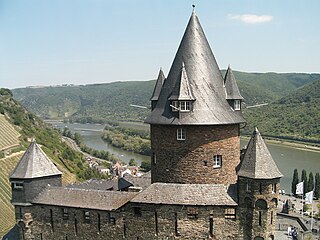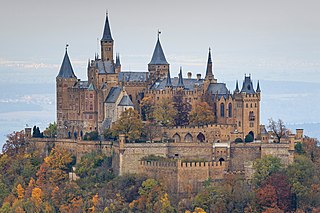
Katzenelnbogen is the name of a castle and small town in the district of Rhein-Lahn-Kreis in Rhineland-Palatinate, Germany. Katzenelnbogen is the seat of the Verbandsgemeinde Aar-Einrich.

Stahleck Castle is a 12th-century fortified castle in the Upper Middle Rhine Valley at Bacharach in Rhineland-Palatinate, Germany. It stands on a crag approximately 160 metres (520 ft) above sea level on the left bank of the river at the mouth of the Steeg valley, approximately 50 kilometres (31 mi) south of Koblenz, and offers a commanding view of the Lorelei valley. Its name means "impregnable castle on a crag", from the Middle High German words stahel (steel) and ecke. It has a water-filled partial moat, a rarity in Germany. Built on the orders of the Archbishop of Cologne, it was destroyed in the late 17th century but rebuilt in the 20th and is now a hostel.

Zwingenberg lies in the Bergstraße district in southern Hessen, Germany, south of Frankfurt and Darmstadt, and with the granting of town rights coming in 1274 it is the oldest town on the Hessen Bergstraße.

The Rhine Gorge is a popular name for the Upper Middle Rhine Valley, a 65 km (40 mi) section of the Rhine between Koblenz and Rüdesheim in the states of Rhineland-Palatinate and Hesse in Germany. It was added to the UNESCO list of World Heritage Sites in June 2002 because of its beauty as a cultural landscape, its importance as a route of transport across Europe, and the unique adaptations of the buildings and terraces to the steep slopes of the gorge.

Sankt Goar is a town on the west bank of the Middle Rhine in the Rhein-Hunsrück-Kreis (district) in Rhineland-Palatinate, Germany. It belongs to the Verbandsgemeinde Hunsrück-Mittelrhein, whose seat is in Emmelshausen.

Katz Castle is a castle above the German town of Sankt Goarshausen in Rhineland-Palatinate. The castle stands on a ledge looking downstream from the riverside at Sankt Goar. It was first built around 1371 by Count William II of Katzenelnbogen. The castle was bombarded in 1806 by Napoleon and rebuilt in the late 19th century, in 1896–98. It is now privately owned, and not open for visitors.

Auerbach Castle is one of several fortresses along the Bergstrasse in southern Hesse, Germany. The castle was originally built by King Charlemagne and rebuilt by Count Diether IV of the Katzenelnbogen dynasty in the second quarter of the 13th century. Today it remains standing atop a hill known as Urberg above the town of Bensheim-Auerbach.

Sankt Goarshausen is a town located in the Rhein-Lahn-Kreis in Nassau on the eastern shore of the Rhine, in the section known as the Rhine Gorge, directly across the river from Sankt Goar, in the German state Rhineland-Palatinate. It is located within the Nassau Nature Park and the Rhine Gorge UNESCO world heritage site, and was historically part of the Duchy of Nassau. It lies approximately 30 km south of Koblenz, and it is above all famous for the Lorelei rock nearby. Sankt Goarshausen is the seat of the Loreley collective municipality. The town's economy is based on wine making and tourism.

Middle Rhine is the section of the Rhine between Bingen and Bonn in Germany. It flows through the Rhine Gorge, a formation created by erosion, which happened at about the same rate as an uplift in the region, leaving the river at about its original level, and the surrounding lands raised. This gorge is quite deep, about 130 metres (430 ft) from the top of the rocks down to the average water-line.

Hohenzollern Castle is the ancestral seat of the imperial House of Hohenzollern. The third of three hilltop castles built on the site, it is located atop Mount Hohenzollern, above and south of Hechingen, on the edge of the Swabian Jura of central Baden-Württemberg, Germany. The name derives from Söller (terrace) from Latin solarium.

Maus Castle is a castle above the village of Wellmich in Rhineland-Palatinate, Germany. It lies on the east side of the Rhine, north of Katz Castle in Sankt Goarshausen and opposite Rheinfels Castle at Sankt Goar across the river.

Pfalzgrafenstein Castle is a toll castle situated on Falkenau island in the Rhine River, adjacent to Kaub, Germany. Also known as "the Pfalz", Pfalzgrafenstein Castle has never been destroyed since being established in 1326/27.

Sigmaringen Castle was the princely castle and seat of government for the Princes of Hohenzollern-Sigmaringen. Situated in the Swabian Alb region of Baden-Württemberg, Germany, this castle dominates the skyline of the town of Sigmaringen. The castle was rebuilt following a fire in 1893, and only the towers of the earlier medieval fortress remain. Schloss Sigmaringen was a family estate of the Swabian Hohenzollern family, a cadet branch of the Hohenzollern family, from which the German Emperors and kings of Prussia came. During the closing months of World War II, Schloss Sigmaringen was briefly the seat of the Vichy French Government after France was liberated by the Allies. The castle and museums may be visited throughout the year, but only on guided tours. It is still owned by the Hohenzollern-Sigmaringen family, although they no longer reside there.

Lichtenberg Castle is a ruin of the spur castle type; with a length of 425m (1,394 ft) it is the biggest castle ruin in Germany. It is located near Thallichtenberg in the district of Kusel in Rhineland-Palatinate.

Hesse-Rheinfels was created as a cadet line of Hesse for Philip II, Landgrave of Hesse-Rheinfels (1541–1583), landgrave from 1567 until 1583, and as a cadet line of Hesse-Kassel for Ernest, Landgrave of Hesse-Rheinfels (1623–1693), landgrave from 1627 until 1658.

The County of Katzenelnbogen was an immediate state of the Holy Roman Empire. It existed between 1095 and 1479, when it was inherited by the Landgraves of Hesse.

Battenberg Castle is a castle ruin near Battenberg in the county of Bad Dürkheim in the state of Rhineland-Palatinate, Germany.

Landgrave Ernest of Hesse-Rheinfels-Rotenburg was from 1649 to 1658 Landgrave of Hesse-Rheinfels and from 1658 until his death Landgrave of Hesse-Rheinfels-Rotenburg. Because his brothers died young, all later Landgraves in the Rotenburg Quarter are descendants of Ernest. Hence, Ernest is known as the ancestor of the Catholic Rotenburg Quarter, a group of junior lines of the House of Hesse.

Falkenstein Castle, also called New Falkenstein (Neu-Falkenstein), is a ruined hill castle at 450 m above sea level (NHN) in the eponymous climatic spa of Falkenstein, a quarter of Königstein im Taunus in the county of Hochtaunuskreis in the German state of Hesse.

A butter-churn tower is a two-part defensive tower in which the upper section has a smaller width than the lower section.























